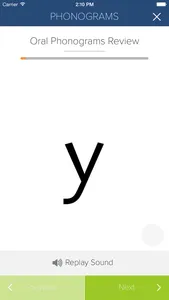Welcome to The Spalding Method ™ Phonograms app!
NOTICE: Upon installing this mobile application, you are agreeing to the terms and conditions.
This Spalding Phonograms app is designed for helping students learn the phonics connection between speech sounds and written symbols that represent those sounds (phonograms). Learning the phonograms is essential for accurate and automatic reading, writing, and spelling. Teaching all the sounds of the phonemes represented by an alphabet letter or combination of two, three, or four letters (phonograms) enables students to read, spell, and write high-frequency words quickly. Students who learn the phonograms well expand their vocabulary and are able to use effective and creative communication skills in writing. Critical thinking is involved in learning the appropriate phonogram placement within words for accurate spelling and for applying information learned during phonogram reviews to pronounce unfamiliar words.
The Spalding Phonograms app is for students that need additional practice, including home schooling, ESL (English as a Second Language), ELL (English Language Learners), ESOL (English for Speakers of Other Languages) students, and those with dyslexia or other learning disabilities. The school and home connection is encouraged through collaboration and communication with the teacher, parent, and student for practicing the phonograms appropriately and adequately. The Spalding Phonograms app aligns with the core reading foundational skills required by state and national standards that are most crucial to the development of early reading success and reading comprehension, including:
• Phonemic awareness
• Feature recognition
• Letter recognition
• Sound-symbol relationships (decoding)
The Spalding Phonograms app provides the following options for all 87 phonograms.
• Phonogram Introduction by selected group – The student sees the phonograms in order of instruction in The Writing Road to Reading, listens to the teacher say the sound(s), and then says the sound(s).
• Oral Phonogram Review – A random phonogram card is show, followed by a pause. The student says the sound(s) and then listens to check accuracy.
• Written Phonogram Review –The student hears the phonogram sounds, followed by a pause; the student repeats the sound(s), listens for a cue, if needed, and then writes the phonogram on lined paper. The card is immediately shown so the student can check for accuracy.
• Differentiated Practice – Specific phonograms (from all 87) can be selected that need more practice. These phonograms can then be practiced in Phonogram Introduction, Oral Phonogram Review, or Written Phonogram Review.
NOTICE: Upon installing this mobile application, you are agreeing to the terms and conditions.
This Spalding Phonograms app is designed for helping students learn the phonics connection between speech sounds and written symbols that represent those sounds (phonograms). Learning the phonograms is essential for accurate and automatic reading, writing, and spelling. Teaching all the sounds of the phonemes represented by an alphabet letter or combination of two, three, or four letters (phonograms) enables students to read, spell, and write high-frequency words quickly. Students who learn the phonograms well expand their vocabulary and are able to use effective and creative communication skills in writing. Critical thinking is involved in learning the appropriate phonogram placement within words for accurate spelling and for applying information learned during phonogram reviews to pronounce unfamiliar words.
The Spalding Phonograms app is for students that need additional practice, including home schooling, ESL (English as a Second Language), ELL (English Language Learners), ESOL (English for Speakers of Other Languages) students, and those with dyslexia or other learning disabilities. The school and home connection is encouraged through collaboration and communication with the teacher, parent, and student for practicing the phonograms appropriately and adequately. The Spalding Phonograms app aligns with the core reading foundational skills required by state and national standards that are most crucial to the development of early reading success and reading comprehension, including:
• Phonemic awareness
• Feature recognition
• Letter recognition
• Sound-symbol relationships (decoding)
The Spalding Phonograms app provides the following options for all 87 phonograms.
• Phonogram Introduction by selected group – The student sees the phonograms in order of instruction in The Writing Road to Reading, listens to the teacher say the sound(s), and then says the sound(s).
• Oral Phonogram Review – A random phonogram card is show, followed by a pause. The student says the sound(s) and then listens to check accuracy.
• Written Phonogram Review –The student hears the phonogram sounds, followed by a pause; the student repeats the sound(s), listens for a cue, if needed, and then writes the phonogram on lined paper. The card is immediately shown so the student can check for accuracy.
• Differentiated Practice – Specific phonograms (from all 87) can be selected that need more practice. These phonograms can then be practiced in Phonogram Introduction, Oral Phonogram Review, or Written Phonogram Review.
Show More



